There are many content marketing phrases that can make you roll your eyes. One of my favorites is “Content is king”. Yes, it's the most overused phrase when we talk about content marketing.
However, there is a reason why this phrase exists. It points to an undeniable fact that there is no better way to reach your target market than creating and sharing relevant and engaging content with them.
And this is where content strategy comes in handy.
In this posts series of creating a content roadmap, this is the last part where we talk about different tools and strategies to get the right content for your website audience.
To read the other two parts, click on these links:
Million Dollar Content Road Map: The Definitive Guide – Part 1
Million Dollar Content Road Map: The Definitive Guide – Part 2
Page Elements
Now that we have the core content best practices let's look at page elements.
Header Tags
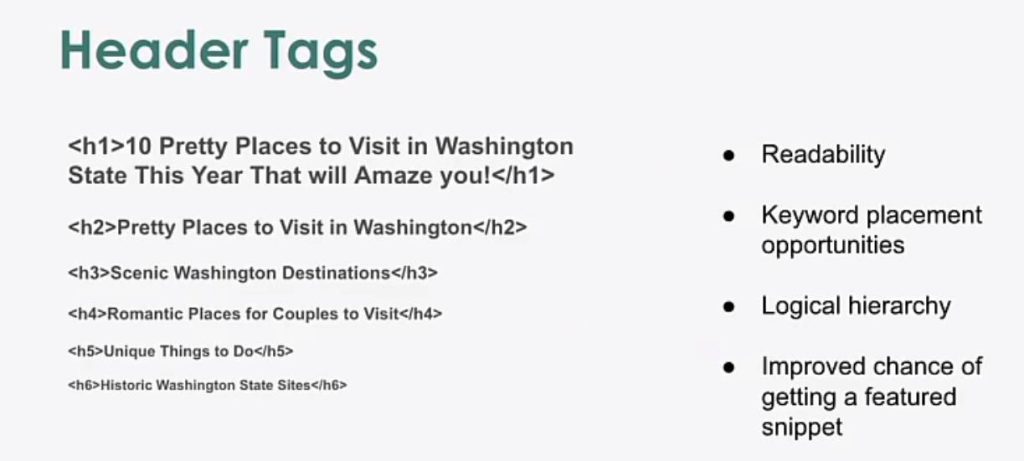
For those of us that are familiar with SEO or even HTML should be commonplace.
Unfortunately, a lot of content management systems and themes are built in such a way that they don't always make this as simple as it otherwise could be.
If I could tell you the number of times that we are working with a client's website out of the box theme and the header tag structure is ill-formatted or ill-coded in the back end.
Nevertheless, there's a methodology for this structure which is why it's part of the core HTML elements.
You want your h1 header to be your primary headline.
Header tags break up readability. They're good both for users as well as for SEO.
It's often suggested to put primary or secondary terms in these header tags which is thought to hold higher weight in the search engines.
These improve readability. They help with keyword placement opportunities. They create a high logical hierarchy in your content which allows people to have a better experience when they're digesting your content and then also these can improve your chances of getting a featured snippet.
So don't forget to pay attention to your header tag in your header tag structure.
It's one of those things that are should be commonplace but is missed more times than you would imagine.
Media
This is another area of opportunity which I think is low-hanging fruit for a lot of content creators.
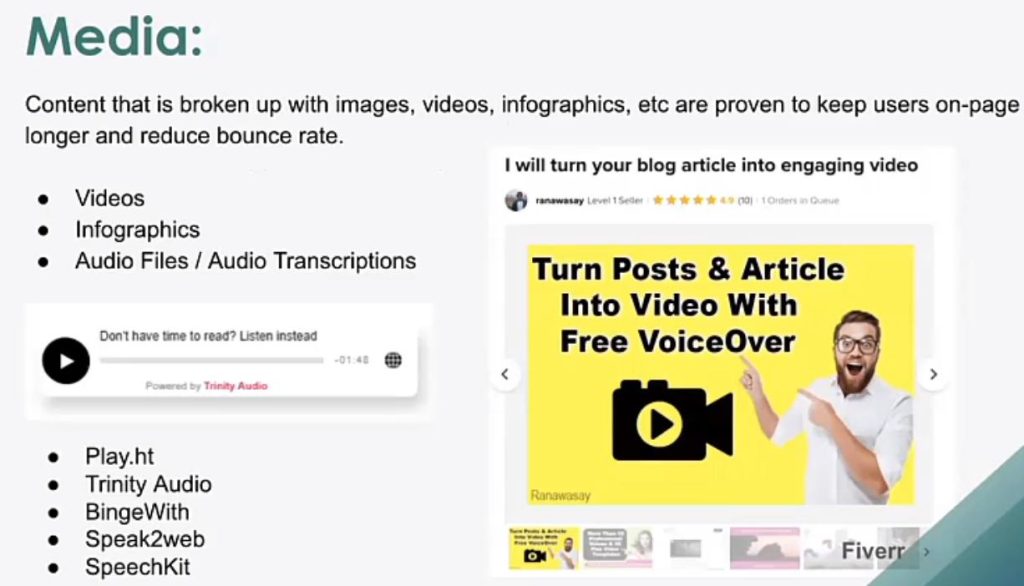
One of the things that we like to do not only with our own content but encourage our clients to do is to create multimedia in their content pieces.
We live in a mobile world, a fast-paced world and so depending on how somebody is engaging with your content, they may start out reading it and then have to jump into another format.
I'll give you an example, this happened to me just not too long ago. I was reading an article on my way out the door but had to leave for an appointment and luckily the particular article I was reading had an audio snippet.
Normally what I would do is, I would just stop reading the article and maybe never come back to it.
In this case, it had an audio snippet, so I put in my headphones, was able to listen to the rest of the article and so user engagement is being rewarded as a result.
There are a number of different tools and processes by which you can embed media. Audio media is a great tool.
There's a lot of tools like um play.ht, trinity audio, bingewith, that will allow you to take your audio or take your text and convert it into audio and embed that right in your article.
Gonna be a great user engagement tool.
And then also there are services literally you can go on Fiverr and find a lot of these services where people for five, ten bucks will take your blog article and turn it into an engaging video snippet and this you can embed right in after the opener of your paragraph.
It's again just another way to encourage greater engagement depending on how people want to digest your content.
Metadata
Let's talk about metadata.

Whether you use a tool like this which is a web-based tool or you're using a plug-in, the main takeaway is to not forget about the character limitations and optimization of your metadata.
If you've been doing SEO for any time, this is something that should be on your list.
I always encourage and tell clients is the search engine results, your title and your description, it's kind of like free advertising.
This is the very first opportunity for a lot of people to interface with your website. So before they ever actually visit your website this is the first experience and it can make or break the difference between that conversion or not
Another part as a conjunction of your title analysis that you want to pay attention to.
Meta Titles
Let's talk about meta titles and some structures and templates that we can provide to our writing team.
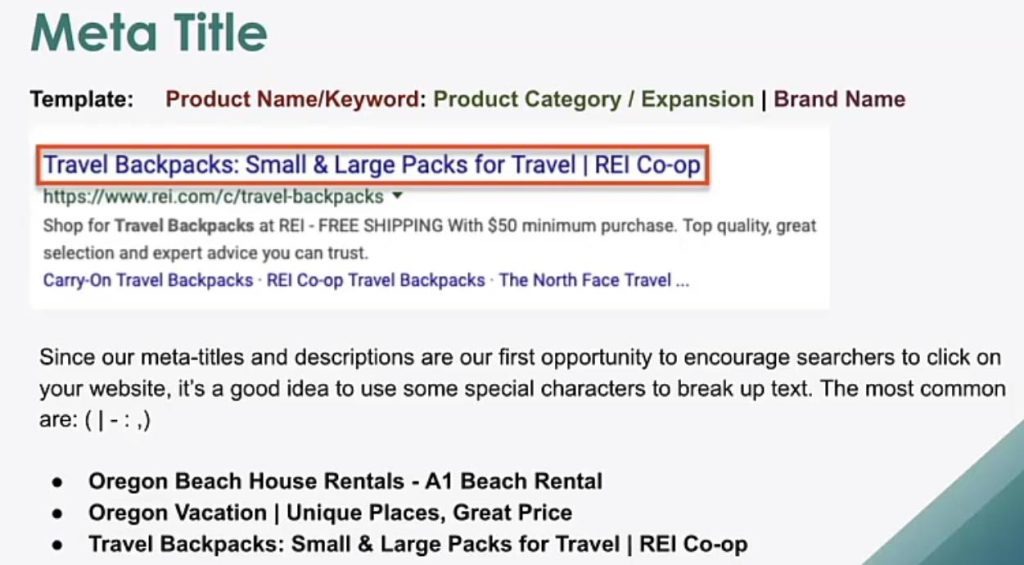
This is an example of what I thought was really well structured meta title. This is from a company called REI.
In this case, they list the product name or their keyword “travel backpacks” and then they put the product category “small and large packs for travel” and then they're putting their brand name.
Now, this exact template might not work for every instance but in the case of a product category, it worked quite well.
It kind of checks all the boxes.
Since our descriptions and our titles are the first opportunities to encourage click through from the search engines, we want to try to stand out amongst the pack.
If you look lower in the above image, you'll notice some ways to do that.
Whether you're using brackets or dashes in addition to the copy itself, you want to add characteristics that are going to pop in search, that is going to stand out and encourage eyeballs and then clicks.
Meta Descriptions
Next, we'll talk about meta descriptions and just kind of some of the best practices here.
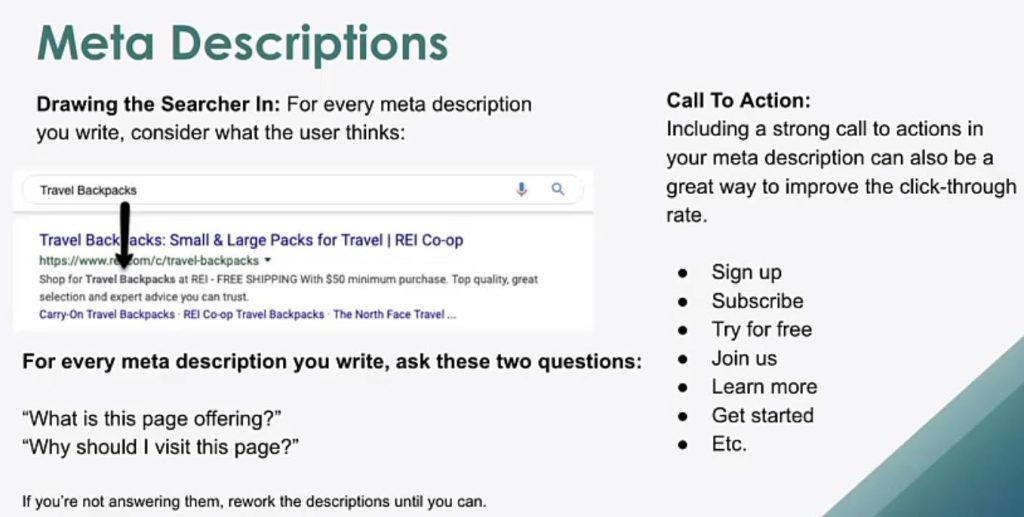
For every meta description, you want to consider what the user's thinking.
One of the challenges that we put on our writing team is having them answer one of two questions when they're creating metadata.
What is the page offering or why should I visit the page?
If your meta description does not answer one of those two questions, you probably want to go back and re-write it or rework it.
Also, where possible it's good to include a call to action whether that's sign up subscribe, learn more, get started, etc. That's another important model for how to craft your meta description so that they convert.
Schema Markup
Next, we'll talk about schema.
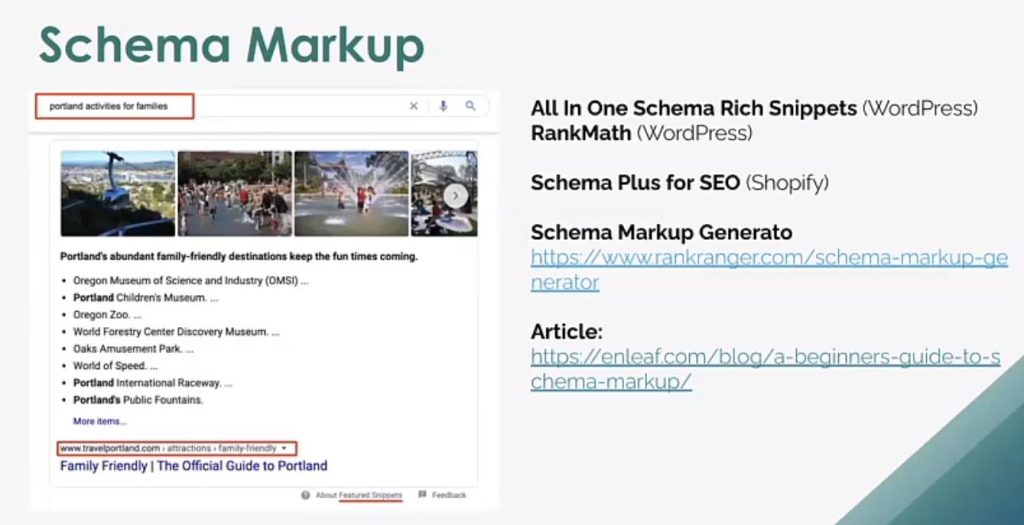
I'm not going to go into great detail on schema other than just to say that this is an important aspect that kind of fits somewhat into the realm of metadata.
There are a lot of great tools whether you're using cms like WordPress or Shopify that will do some of the work for you. Rank math, all in one schema are our decent tools for WordPress.
There's Schema Plus for SEO for Shopify.
And we have a very well written detailed guide on our blog explaining everything about Technical SEO. Do not forget to give it a read.
The reason that schema markup can be helpful one, that it's just one more opportunity to build additional context in the code behind and then the cherry on top is that it could potentially result in a rich snippet which is another way to stand out in the search results.
URL Structure
Next, I want to talk about URL structure.
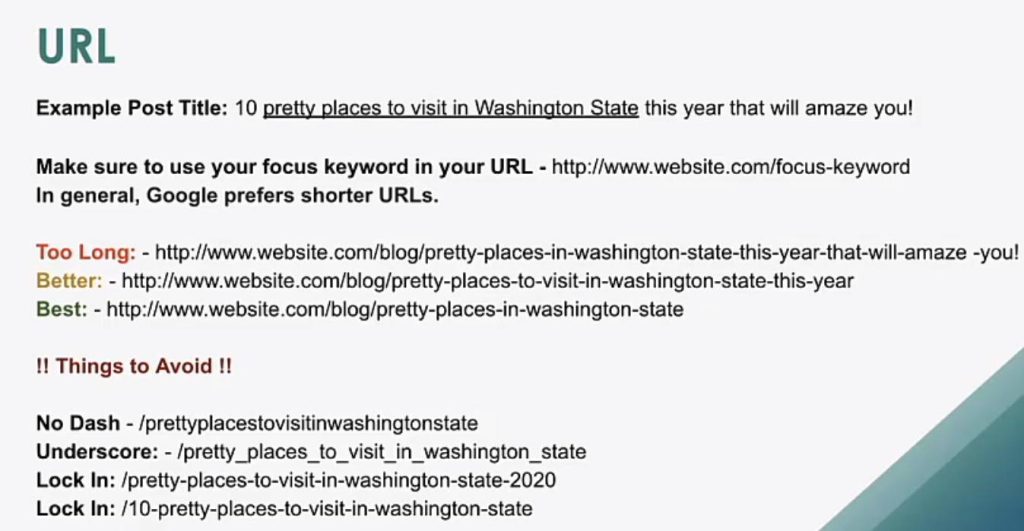
This is again an outline that we provide to a lot of our content team of things to do and not to do and to look out for.
Again in our example, we have the title “10 pretty places to visit in Washington state this year that will amaze you”.
You wanna make sure that your focus keyword is in your title
Also, you want to pay attention to the size. This is something that is kind of debated now but we still kind of like short and concise URLs.
In the above image, you can see on top is fairly long. If we're using the entire subject matter, it's just a very long URL.
A better one is that in the middle.
But the one that I tend to gravitate to is “pretty places in Washington state”.
It primarily retains the keyword but it takes away the numerical value and there is a reason for that which I'll explain.
Some of the things that I like to avoid when it comes to URLs is what I call URL lock-in.
For instance, I was to create a URL that says “10 pretty places to visit in Washington state”. The problem with that is what happens if one of those places goes away or what happens if you know six months down the road I want to update this article to 20 pretty places to visit in Washington.
Well, now I have to break the URL and do a 301 redirect.
Not only is it a lot of added work, but there are also some potential downsides to doing 301 redirects as opposed to just keeping the URL intact.
So always think through your URLs.
Not only to make sure that URLs have the proper structure but to make sure that you're not in any kind of lock-in situation that that URL will be relevant to the content whether the content stays the same or adapts and grows over time.
ALT Text
Pretty standard SEO stuff here but often miss.
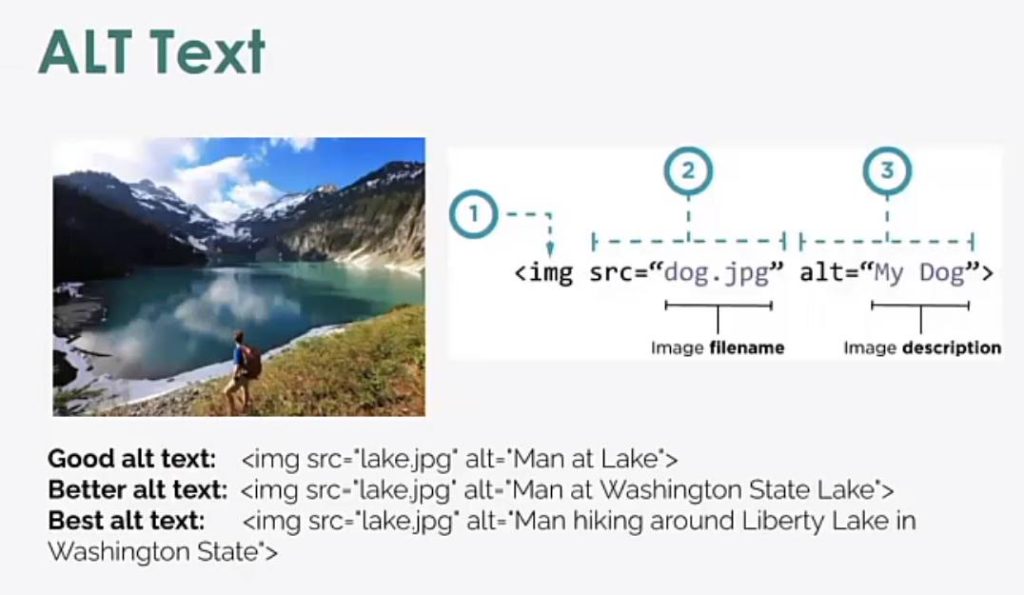
We see so much of the time where alt text is kind of ignored just because it's somewhat lower in the priority list.
We have a mixed approach when it comes to keywords in the alt text.
If it makes sense, we will try to work the keyword into the alt text not to keyword stuff it but make sure that what we're describing in the alt text both is relevant to the image and if we can also make it relevant to the subject matter the keyword we'll do that as well.
Keyword Placement
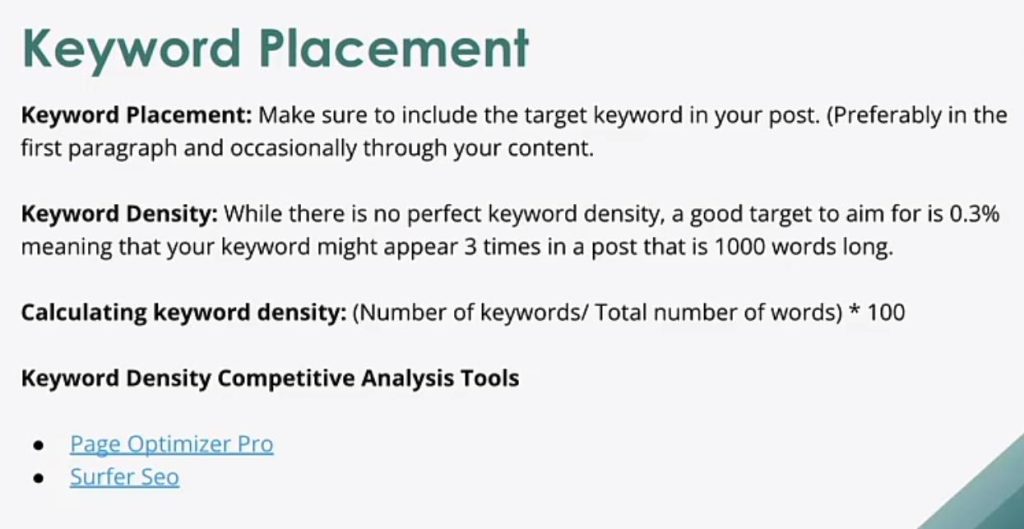
You want to make sure that you include your target keyword in your post.
It's best practice to get that into the first paragraph.
Keyword density is kind of a dirty word these days but the general ideation or subject matter of keyword density is still relevant.
Luckily these days there are a lot of tools that allow us to kind of backwards engineer how many times the keyword should be in a particular post.
But the general rule of thumb is around three times in a post of a thousand words.
That's a rough tool that can be approximated but that's a rough tool you can hand to your writers that might otherwise not know if they should put a keyword in your subject matter or not.
All the things that we have outlined above also comes under our technical SEO services. Contact Us or Chat with us online to learn more about our services.
Deep Analysis – Content Auditing
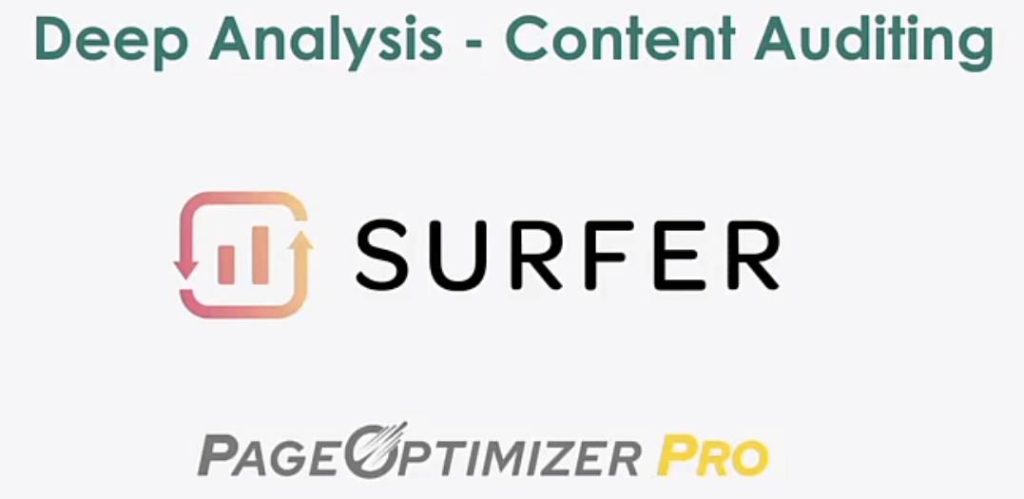
So once we've kind of created our whole roadmap we've articulated some of the baseline structure and research to our content team.
They send that back essentially to the SEO team and that's where we can start doing deep analysis and content auditing.
Hopefully, by this time with enough data set up, this is really just fine-tuning and these are some of our favourite tools for deep analysis and content auditing.
Surfer and PageOptimizerPro are again two tools that do a lot of the same things.
Essentially help you audit your content by looking at the competitive range and making suggestions based on that.
AI Writing Tools
I will talk a little bit about AI writing tools.
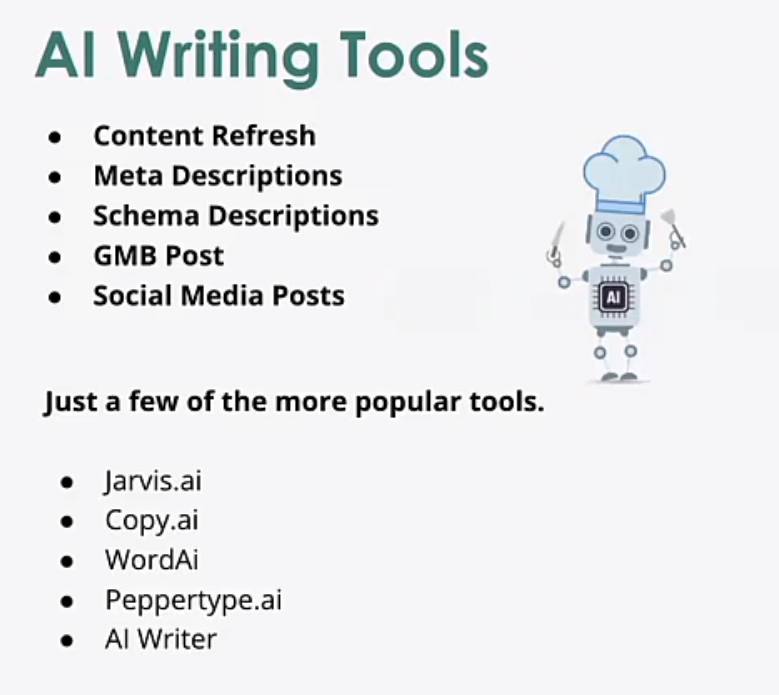
We don't use AI writing tools extensively.
There are times when we will use them and I'll go through that in just a second here but essentially we have found, at least for our clients, a lot of times it takes about as much time to review and audit content that's being generated by ai tools than it would to just have you know our writing teams create something.
For us, as far as long-form content, we really haven't found a great process to work with these tools but I will tell you how we use ai writing tools in some of our processes and where they have been beneficial.
From our experience, where ai writing tools can pull their weight is in short form content.
Earlier I talked about lock-in with URLs. One of the things that we recommend in addition to just simply creating content is going back and updating content once it's aged.
That's probably one of the best things you can do is go back and update and refresh old content.
AI tools can be great for that because a lot of times you can pull in or put in a little data point and it can spit out a paragraph or two relevant to an older piece of content.
That's one area where we'll use AI writing tools to create maybe a paragraph or two of supplemental content.
Sometimes it can be good for initial ideation around meta descriptions.
Lately, we've been using it a lot for schema descriptions.
For instance, if we have a client that doesn't have you know schema yet or working on their schema, we can go through and quickly generate 300 – 400 word schema descriptions that are composites of their existing content.
It's also great for content for you know Google My Business posts, social media posts and stuff like that.
That's how we use ai writing tools. I'm not a huge focus on this topic but I figured it is relevant so I would bring it in.
In the above image, we showed just some of the many tools.
This is an example of the guides that we provide.
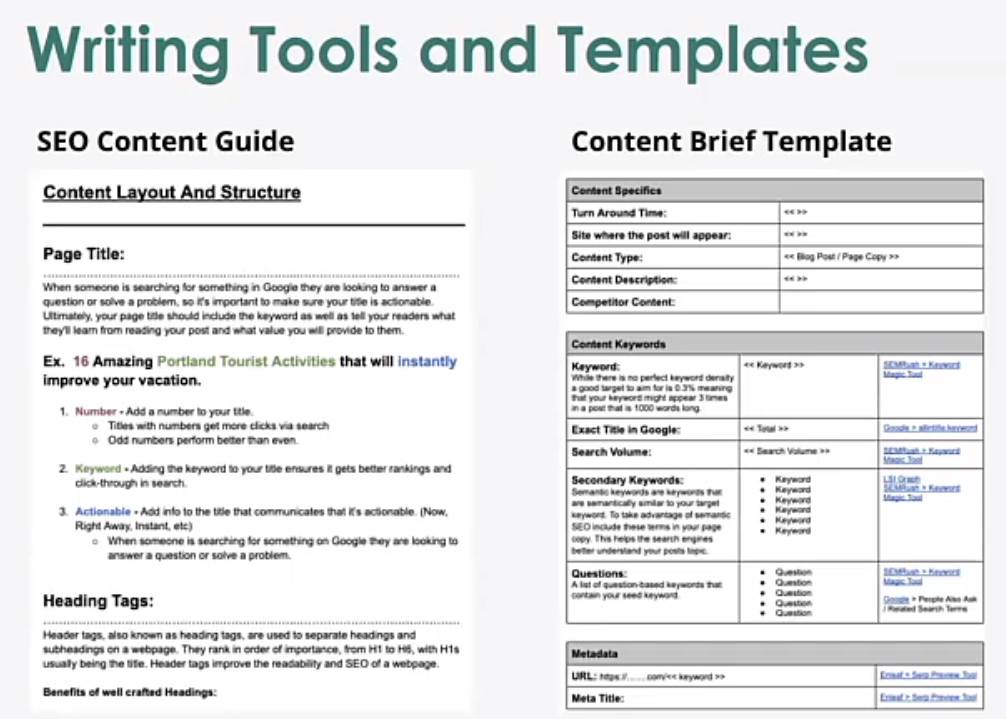
Everyone has their own processes, we like to be very procedural.
A lot of the stuff that's gone into this talk is stuff that we've articulated with an SEO content guide and brief.
In the above image, on the left is an example of our overview this helps a writer regardless of how experienced they are with SEO to have a quick key or legend to understand the rationale behind why you would write this way?
Whereas the element on the right is our content brief template.
This is a two-fold template that we use both for our writers as well as it's an asset piece that we provide to our clients.
You can also download this template for free here:
That essentially concludes this post.
Hopefully, you found some good.
Final Words
The content roadmap can help you stay organized, on task, and be successful in your SEO efforts. You know where you're going, you know how to get there, and you can see when you're finished.
The process of writing content on the web is extremely straightforward. Use the points outlined above to help you understand exactly how to follow a process that will allow you to create great quality content for your site.
This will keep your audience engaged and make them more likely to share your content with others.
These are all good steps for creating successful SEO-friendly web content, which is what we are ultimately trying to accomplish. Our recommendations are based on our experience in successful content marketing and our expertise in optimizing it for search engines.
Here's to hoping that this content roadmap acts as a stepping stone in making sure your web design, development and content writing teams stay in tune with one another and help build your business further.
Let us know in the comments below how are you liking these posts series that we are lately building up on our blog.


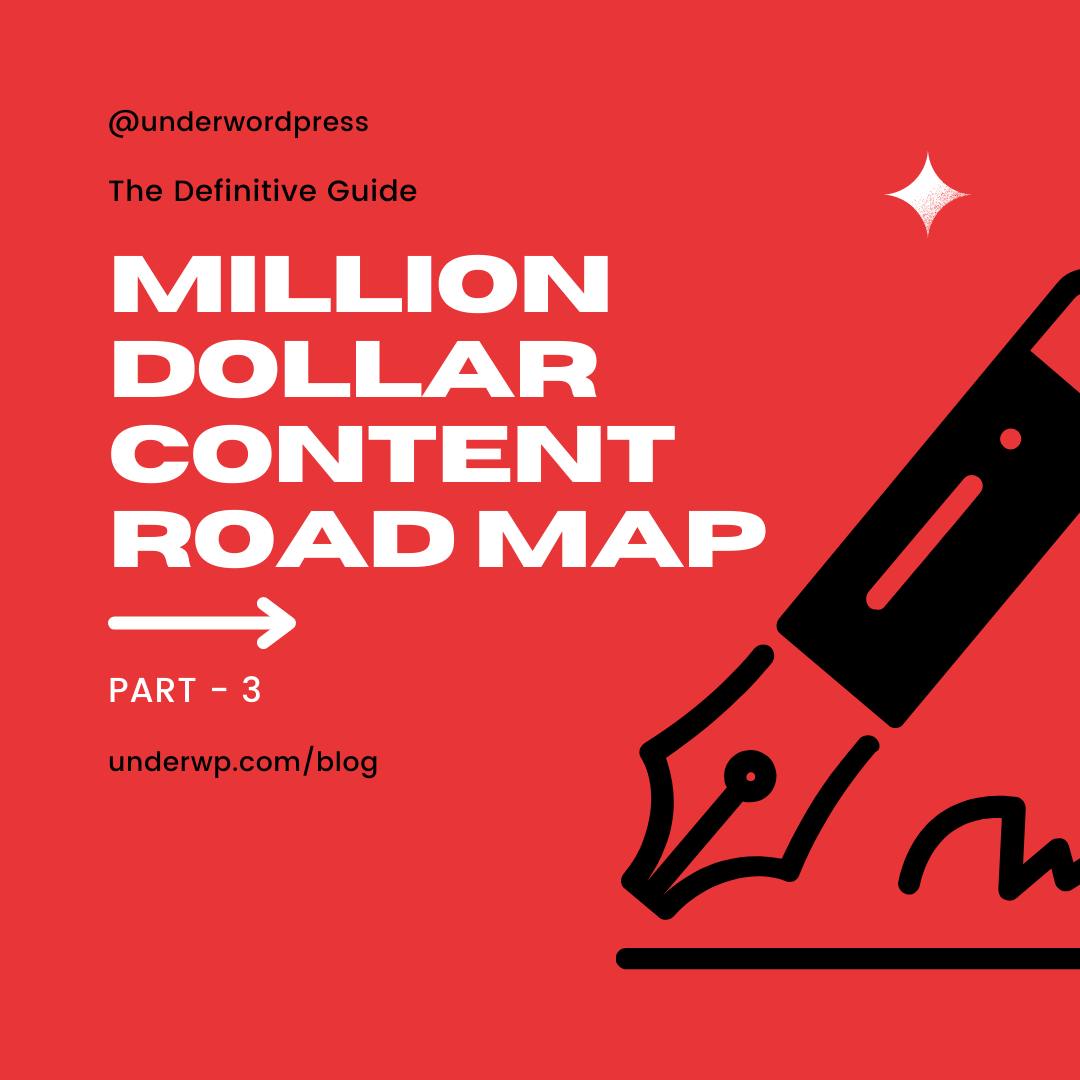
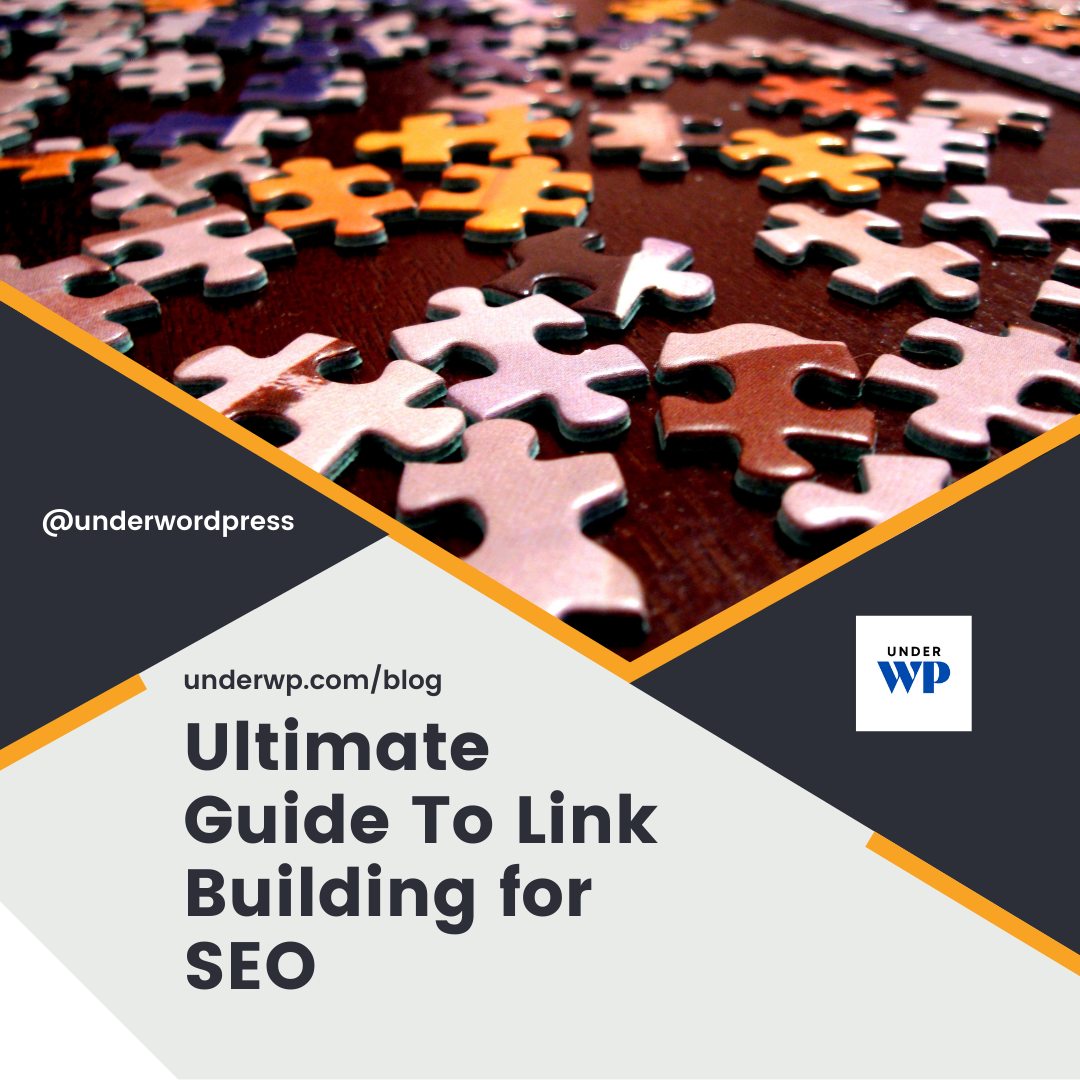

It’s hard to come by knowledgeable people on this topic, but you seem like you know what you’re talking about! Thanks
I have started to like reading this post series. Keep them coming.